wipers SKODA FABIA 2005 1.G / 6Y Owner's Manual
[x] Cancel search | Manufacturer: SKODA, Model Year: 2005, Model line: FABIA, Model: SKODA FABIA 2005 1.G / 6YPages: 260
Page 64 of 260
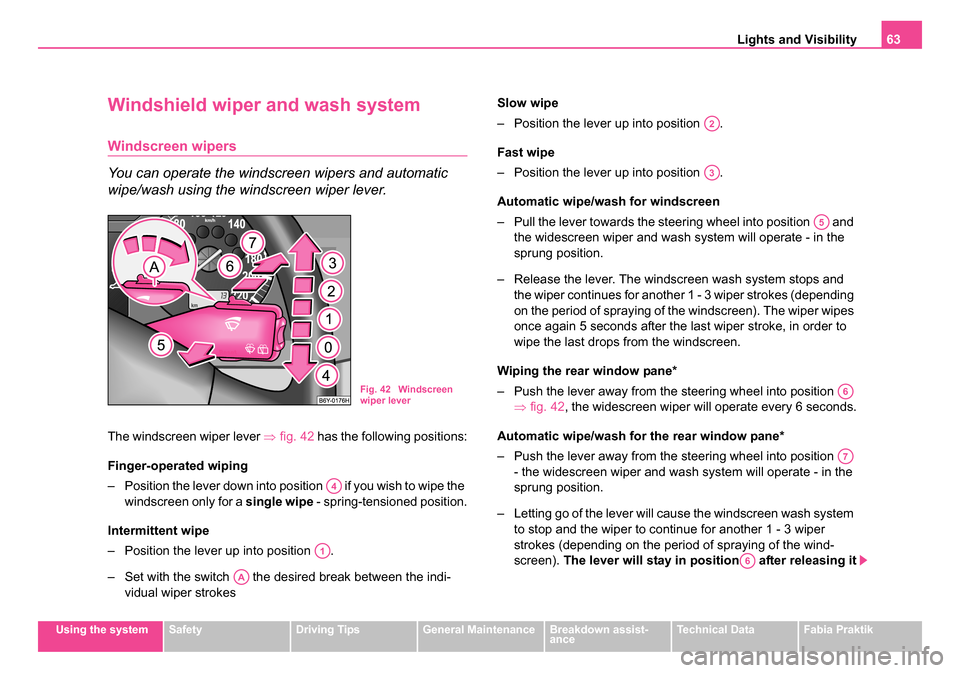
Lights and Visibility63
Using the systemSafetyDriving TipsGeneral MaintenanceBreakdown assist-
anceTechnical DataFabia Praktik
Windshield wiper and wash system
Windscreen wipers
You can operate the windscreen wipers and automatic
wipe/wash using the windscreen wiper lever.
The windscreen wiper lever ⇒fig. 42 has the following positions:
Finger-operated wiping
– Position the lever down into position if you wish to wipe the windscreen only for a single wipe - spring-tensioned position.
Intermittent wipe
– Position the lever up into position .
– Set with the switch the desired break between the indi- vidual wiper strokes Slow wipe
– Position the lever up into position .
Fast wipe
– Position the lever up into position .
Automatic wipe/w
ash for windscreen
– Pull the lever towards the steering wheel into position and the widescreen wiper and wash system will operate - in the
sprung position.
– Release the lever. The windscreen wash system stops and the wiper continues for another 1 - 3 wiper strokes (depending
on the period of spraying of the windscreen). The wiper wipes
once again 5 seconds after the last wiper stroke, in order to
wipe the last drops from the windscreen.
Wiping the rear window pane*
– Push the lever away from the steering wheel into position ⇒fig. 42 , the widescreen wiper will operate every 6 seconds.
Automatic wipe/wash for the rear window pane*
– Push the lever away from the steering wheel into position - the widescreen wiper and wash system will operate - in the
sprung position.
– Letting go of the lever will cause the windscreen wash system to stop and the wiper to continue for another 1 - 3 wiper
strokes (depending on the period of spraying of the wind-
screen). The lever will stay in position after releasing it
Fig. 42 Windscreen
wiper lever
A4
A1
AA
A2
A3
A5
A6
A7
A6
sqc.1.book Seite 63 Mittwoch, 13. April 2005 1:09 13
Page 65 of 260
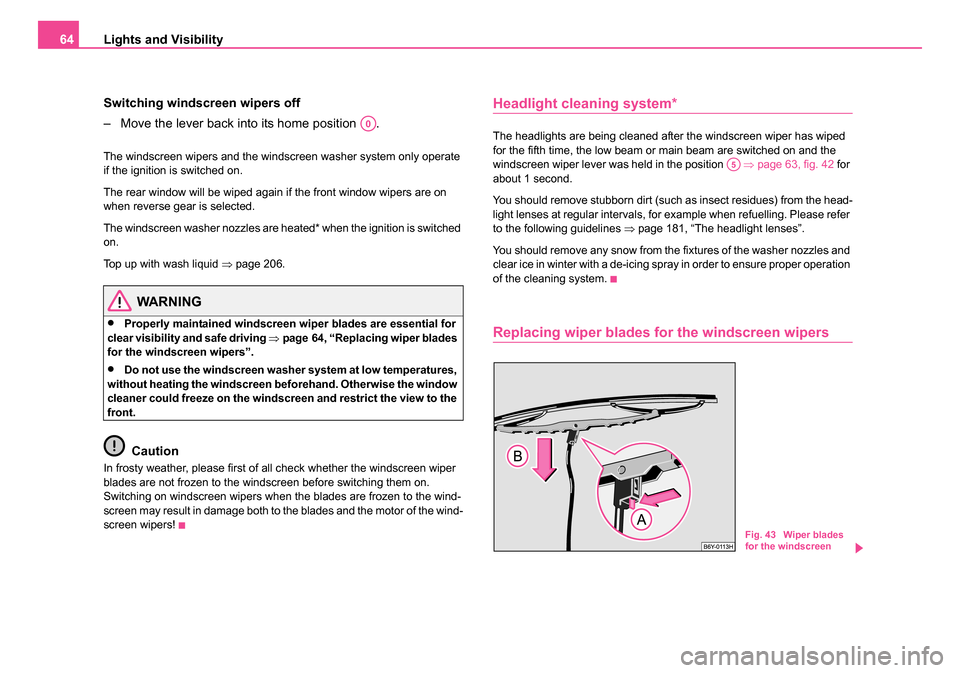
Lights and Visibility
64
Switching windscreen wipers off
– Move the lever back into its home position .
The windscreen wipers and the windscreen washer system only operate
if the ignition is switched on.
The rear window will be wiped again if the front window wipers are on
when reverse gear is selected.
The windscreen washer nozzles are heated* when the ignition is switched
on.
Top up with wash liquid ⇒page 206.
WARNING
•Properly maintained windscreen wiper blades are essential for
clear visibility and safe driving ⇒page 64, “Replacing wiper blades
for the windscreen wipers”.
•Do not use the windscreen washer system at low temperatures,
without heating the windscreen beforehand. Otherwise the window
cleaner could freeze on the windscreen and restrict the view to the
front.
Caution
In frosty weather, please first of all check whether the windscreen wiper
blades are not frozen to the windscreen before switching them on.
Switching on windscreen wipers when the blades are frozen to the wind-
screen may result in damage both to the blades and the motor of the wind-
screen wipers!
Headlight cleaning system*
The headlights are being cleaned after the windscreen wiper has wiped
for the fifth time, the low beam or main beam are switched on and the
windscreen wiper lever was held in the position ⇒page 63, fig. 42 for
about 1 second.
You should remove stubborn dirt (such as insect residues) from the head-
light lenses at regular intervals, for example when refuelling. Please refer
to the following guidelines ⇒page 181, “The headlight lenses”.
You should remove any snow from the fixtures of the washer nozzles and
clear ice in winter with a de-icing spray in order to ensure proper operation
of the cleaning system.
Replacing wiper blades fo r the windscreen wipers
A0
A5
Fig. 43 Wiper blades
for the windscreen
sqc.1.book Seite 64 Mittwoch, 13. April 2005 1:09 13
Page 66 of 260
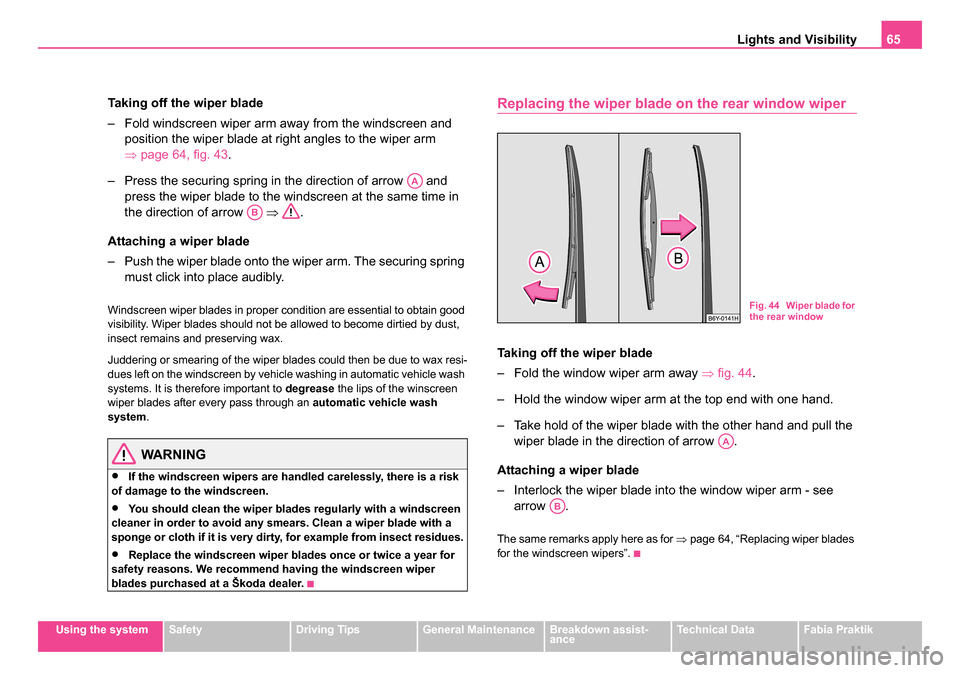
Lights and Visibility65
Using the systemSafetyDriving TipsGeneral MaintenanceBreakdown assist-
anceTechnical DataFabia Praktik
Taking off the wiper blade
– Fold windscreen wiper arm away from the windscreen and
position the wiper blade at right angles to the wiper arm
⇒page 64, fig. 43 .
– Press the securing spring in the direction of arrow and press the wiper blade to the windscreen at the same time in
the direction of arrow ⇒.
Attaching a wiper blade
– Push the wiper blade onto the wiper arm. The securing spring must click into place audibly.
Windscreen wiper blades in proper condition are essential to obtain good
visibility. Wiper blades should not be allowed to become dirtied by dust,
insect remains and preserving wax.
Juddering or smearing of the wiper blades could then be due to wax resi-
dues left on the windscreen by vehicle washing in automatic vehicle wash
systems. It is therefore important to degrease the lips of the winscreen
wiper blades after every pass through an automatic vehicle wash
system .
WARNING
•If the windscreen wipers are handled carelessly, there is a risk
of damage to the windscreen.
•You should clean the wiper blades regularly with a windscreen
cleaner in order to avoid any smears. Clean a wiper blade with a
sponge or cloth if it is very dirty, for example from insect residues.
•Replace the windscreen wiper blades once or twice a year for
safety reasons. We recommend having the windscreen wiper
blades purchased at a Škoda dealer.
Replacing the wiper blade on the rear window wiper
Taking off the wiper blade
– Fold the window wiper arm away ⇒fig. 44 .
– Hold the window wiper arm at the top end with one hand.
– Take hold of the wiper blade with the other hand and pull the wiper blade in the direction of arrow .
Attaching a wiper blade
– Interlock the wiper blade into the window wiper arm - see arrow .
The same remarks apply here as for ⇒page 64, “Replacing wiper blades
for the windscreen wipers”.
AA
AB
Fig. 44 Wiper blade for
the rear window
AA
AB
sqc.1.book Seite 65 Mittwoch, 13. April 2005 1:09 13
Page 192 of 260

Inspecting and Replenishing191
Using the systemSafetyDriving TipsGeneral MaintenanceBreakdown assist-
anceTechnical DataFabia Praktik
Opening the bonnet
– Unlock the bonnet ⇒page 190, fig. 138 .
– Ensure that the arms of the windscreen wipers are correctly in place against the windscreen before opening the bonnet
otherwise damage could occur to the paintwork.
– Pulling on the handle ⇒page 190, fig. 139 will lock the bonnet
fully.
– Grip with the hand under the radiator grille and lift up the bonnet.
– Take the bonnet support out of its holder and set it in the opening designed for it ⇒page 190, fig. 140.
Closing the bonnet
– Lift the bonnet slightly and unhook the bonnet support. Press the bonnet support into the holder designed to hold it.
– Allow the bonnet to drop from a height of about 30 cm into the lock - bonnet do not press down on it!
WARNING
•Never open the bonnet if you see that steam or coolant is
flowing out of the engine compartmen t - risk of scalding! Wait long
enough until the steam or coolant has stopped escaping.
•For safety reasons, the bonnet must always be properly closed
when driving. One should therefore check that the lock has in fact
engaged properly after closing the bonnet.
•Stop your vehicle immediately wh ile driving if you notice that
the lock is not properly engaged and close the bonnet properly -
risk of an accident!
Caution
•Never open the bonnet using the handle - danger of causing damage.
•Before opening the bonnet, ensure that the arms of the windscreen
wipers are correctly in place against the windscreen. Otherwise, there is
a risk of damage to the paintwork.
Working in the engine compartment
Particular care is required when carrying out any work in
the engine compartment!
There is a risk of injuries, scalding, accidents and fire when working
in the engine compartment, e.g. inspecting and re plenishing oil and
other fluids. For this reason, it is essential to comply with the
warning instructions stated below and with the general applicable
rules of safety. The engine compartment of your car is a hazardous
area ⇒
WARNING
•Never open the bonnet if you see that steam or coolant is
flowing out of the engine compartment - risk of scalding! Wait long
enough until the steam or coolant has stopped escaping.
•Switch off the engine and pull out the ignition key.
•Apply the handbrake firmly.
WARNING (continued)
sqc.1.book Seite 191 Mittwoch, 13. April 2005 1:09 13
Page 229 of 260
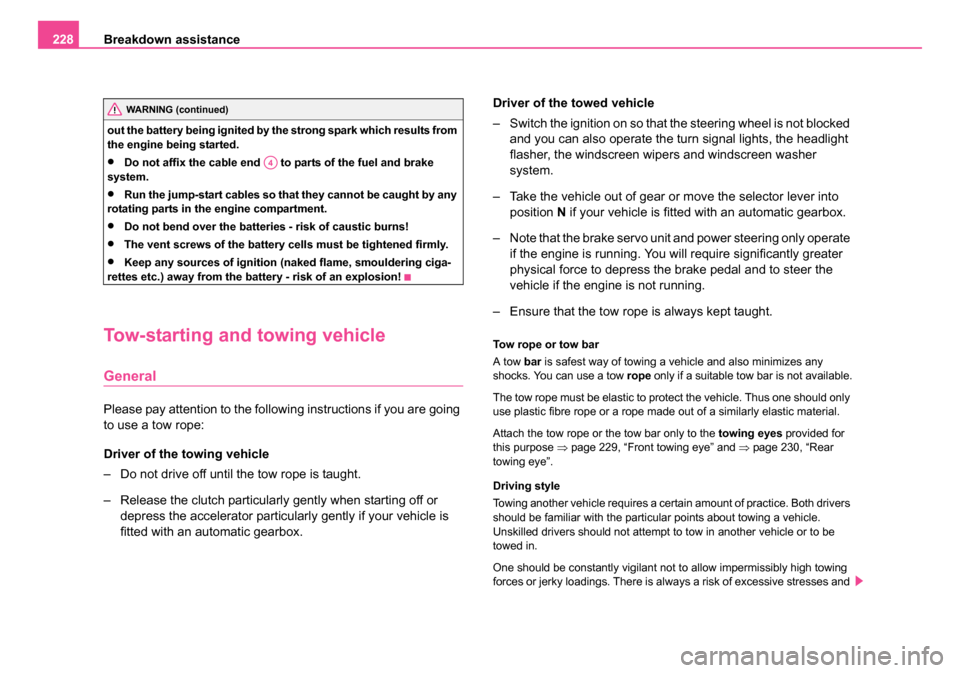
Breakdown assistance
228
out the battery being ignited by the strong spark which results from
the engine being started.
•Do not affix the cable end to parts of the fuel and brake
system.
•Run the jump-start cables so that they cannot be caught by any
rotating parts in the engine compartment.
•Do not bend over the batteries - risk of caustic burns!
•The vent screws of the battery cells must be tightened firmly.
•Keep any sources of ignition (naked flame, smouldering ciga-
rettes etc.) away from the battery - risk of an explosion!
Tow-starting and towing vehicle
General
Please pay attention to the following instructions if you are going
to use a tow rope:
Driver of the towing vehicle
– Do not drive off until the tow rope is taught.
– Release the clutch particularly gently when starting off or depress the accelerator particularly gently if your vehicle is
fitted with an automatic gearbox. Driver of the towed vehicle
– Switch the ignition on so that the steering wheel is not blocked
and you can also operate the turn signal lights, the headlight
flasher, the windscreen wipers and windscreen washer
system.
– Take the vehicle out of gear or move the selector lever into position N if your vehicle is fitted with an automatic gearbox.
– Note that the brake servo unit and power steering only operate if the engine is running. You will require significantly greater
physical force to depress the brake pedal and to steer the
vehicle if the engine is not running.
– Ensure that the tow rope is always kept taught.
Tow rope or tow bar
A tow bar is safest way of towing a vehicle and also minimizes any
shocks. You can use a tow rope only if a suitable tow bar is not available.
The tow rope must be elastic to protect the vehicle. Thus one should only
use plastic fibre rope or a rope made out of a similarly elastic material.
Attach the tow rope or the tow bar only to the towing eyes provided for
this purpose ⇒page 229, “Front towing eye” and ⇒ page 230, “Rear
towing eye”.
Driving style
Towing another vehicle requires a certain amount of practice. Both drivers
should be familiar with the particular points about towing a vehicle.
Unskilled drivers should not attempt to tow in another vehicle or to be
towed in.
One should be constantly vigilant not to allow impermissibly high towing
forces or jerky loadings. There is always a risk of excessive stresses and
WARNING (continued)
A4
sqc.1.book Seite 228 Mittwoch, 13. April 2005 1:09 13
Page 257 of 260
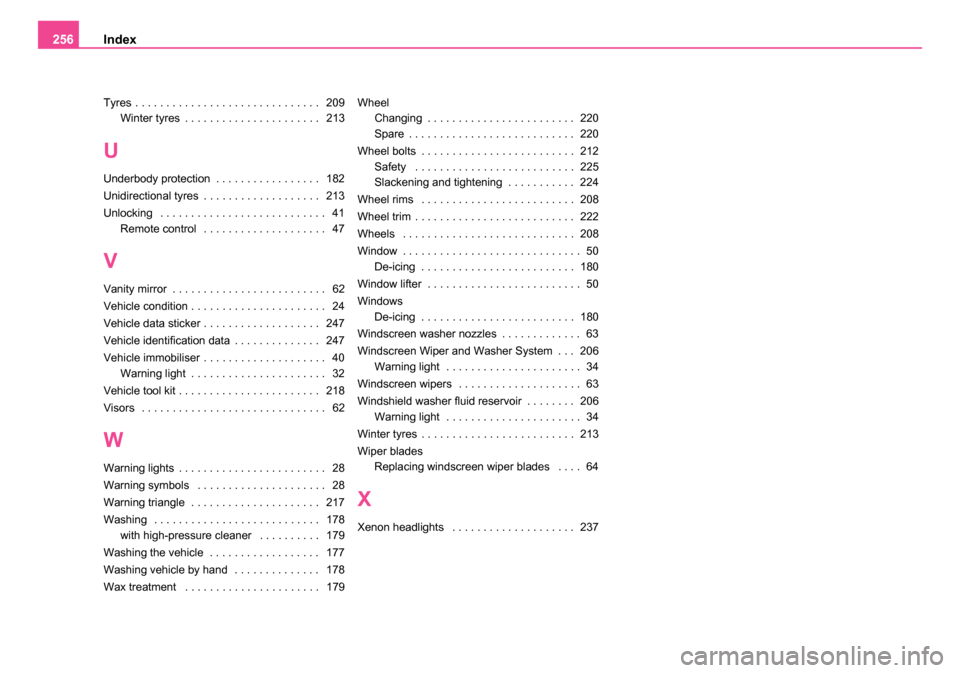
Index
256
Tyres . . . . . . . . . . . . . . . . . . . . . . . . . . . . . . 209
Winter tyres . . . . . . . . . . . . . . . . . . . . . . 213
U
Underbody protection . . . . . . . . . . . . . . . . . 182
Unidirectional tyres . . . . . . . . . . . . . . . . . . . 213
Unlocking . . . . . . . . . . . . . . . . . . . . . . . . . . . 41Remote control . . . . . . . . . . . . . . . . . . . . 47
V
Vanity mirror . . . . . . . . . . . . . . . . . . . . . . . . . 62
Vehicle condition . . . . . . . . . . . . . . . . . . . . . . 24
Vehicle data sticker . . . . . . . . . . . . . . . . . . . 247
Vehicle identification data . . . . . . . . . . . . . . 247
Vehicle immobiliser . . . . . . . . . . . . . . . . . . . . 40Warning light . . . . . . . . . . . . . . . . . . . . . . 32
Vehicle tool kit . . . . . . . . . . . . . . . . . . . . . . . 218
Visors . . . . . . . . . . . . . . . . . . . . . . . . . . . . . . 62
W
Warning lights . . . . . . . . . . . . . . . . . . . . . . . . 28
Warning symbols . . . . . . . . . . . . . . . . . . . . . 28
Warning triangle . . . . . . . . . . . . . . . . . . . . . 217
Washing . . . . . . . . . . . . . . . . . . . . . . . . . . . 178 with high-pressure cleaner . . . . . . . . . . 179
Washing the vehicle . . . . . . . . . . . . . . . . . . 177
Washing vehicle by hand . . . . . . . . . . . . . . 178
Wax treatment . . . . . . . . . . . . . . . . . . . . . . 179 Wheel
Changing . . . . . . . . . . . . . . . . . . . . . . . . 220
Spare . . . . . . . . . . . . . . . . . . . . . . . . . . . 220
Wheel bolts . . . . . . . . . . . . . . . . . . . . . . . . . 212 Safety . . . . . . . . . . . . . . . . . . . . . . . . . . 225
Slackening and tightening . . . . . . . . . . . 224
Wheel rims . . . . . . . . . . . . . . . . . . . . . . . . . 208
Wheel trim . . . . . . . . . . . . . . . . . . . . . . . . . . 222
Wheels . . . . . . . . . . . . . . . . . . . . . . . . . . . . 208
Window . . . . . . . . . . . . . . . . . . . . . . . . . . . . . 50 De-icing . . . . . . . . . . . . . . . . . . . . . . . . . 180
Window lifter . . . . . . . . . . . . . . . . . . . . . . . . . 50
Windows De-icing . . . . . . . . . . . . . . . . . . . . . . . . . 180
Windscreen washer nozzles . . . . . . . . . . . . . 63
Windscreen Wiper and Washer System . . . 206 Warning light . . . . . . . . . . . . . . . . . . . . . . 34
Windscreen wipers . . . . . . . . . . . . . . . . . . . . 63
Windshield washer fluid reservoir . . . . . . . . 206 Warning light . . . . . . . . . . . . . . . . . . . . . . 34
Winter tyres . . . . . . . . . . . . . . . . . . . . . . . . . 213
Wiper blades Replacing windscreen wiper blades . . . . 64
X
Xenon headlights . . . . . . . . . . . . . . . . . . . . 237
sqc.1.book Seite 256 Mittwoch, 13. April 2005 1:09 13